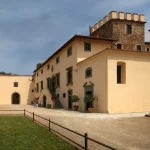Montozzi is first mentioned in 1036, associated with the oppidum of Bulgari, a fortified settlement not far from the current castle of Montozzi. The castle was originally built by the Bulgari, allies of the Lombards who occupied part of Tuscany in the 6th century. It was in the hands of the Sassi family, and the toponym Mons Teuzi derives from Teuzzo of Ildebrando dei Sassi, lord of Bulgari. From 1186 onwards, there are no more records of the Sassi family, who were replaced by the Ubertini family of Arezzo, their former in-laws.
The Ubertini were a family closely tied to the episcopal power of Arezzo. The new castle they commissioned was built on the highest portion of the Bulgari hill, offering a dominant position over the surrounding valleys. The walls followed an elliptical shape, in keeping with the typical layout of Tuscan hilltop fortified villages, with a large central open space or square. Near the village stood the extra-urban church of San Martino di Tours, located along one of the pilgrimage routes to Rome. The castle is mentioned in a 1221 agreement between the Ubertini and the Guidi, in which the latter pledged to allow the Ubertini to retain peaceful possession of the castle.
In 1303, the castle was captured and destroyed by the Florentines in their conflict with the Aretini. Restored by the Ubertini, it met the same fate again in 1326, as the Ubertini had rebelled against Guido Tarlati, bishop and lord of Arezzo. Afterward, it was radically rebuilt once again by the Ubertini. In 1335, the Aretine bishop Buso degli Ubertini submitted to the Guelph Florence, under whose authority the entire Valdambra passed. In 1337, the Florentines constructed a new road along the valley floor to facilitate communication with their city.
In 1385, Azzo di Franceschino degli Ubertini submitted the castle of Montozzi to Florence, and it became part of the podesteria of Valdambra. In 1399, the castle was once again brought under the control of the Florentine Guelphs after a rebellion. Subsequently, its military importance declined, and the power of the Ubertini faded. The walls and the keep were abandoned and fell into ruin.
With the establishment of the Pax Florentina, several families from Florence settled in the lands of the Valdarno and Valdambra, bringing political stability and economic growth to the area. This led to the partial decline of fortified settlements and the flourishing of small open villas, with houses spreading outside the formerly fortified village to better accommodate agricultural activities. In 1454, the statute of the community of Montozzi was drafted, and by the end of the 15th century, the first known contract for lands granted ad medium, or “sharecropping,” was recorded.
Nel 1555 l’intera Valdambra entrò a far parte del Granducato di Toscana.
In the first half of the 16th century, the Bartolini Baldelli family began purchasing properties and land in Montozzi. During the 17th century, the family acquired most of the village and a vast surrounding territory, although their main residences were in Volterra and Florence, where they served for generations as secretaries to the Grand Dukes and held important political and administrative positions. In 1660, brothers Francesco and Ottavio Bartolini Baldelli began the construction of a palace that incorporated the remains of the castle, and they also renovated the village, making it the center of their estate.
Francesco Maria Bartolini Baldelli (1646–1711) embellished the palace with frescoes. He added a double loggia on the garden side, which he adorned with stucco decorations. Finally, he had a new church built on the western side of the palace, dedicated to Saints Martin and Lucia, for which he obtained the patronage from Cosimo III. This church became the parish church, replacing the old church of San Martino di Tours, which was located outside the village and later demolished.
Bartolomeo Bartolini Baldelli (1804–1868) commissioned engineer Pietro Municchi in 1825 to prepare an appraisal of the Montozzi estate, which at the time had 360 inhabitants, distributed among 46 families. He also had various surveys carried out by engineer Eugenio Falciani, including a cadastral map with 34 plates illustrating the farm and its 32 estates. Around 1860, he had a new church built near the cemetery and created a romantic English-style park around the castle, known as la Bandita.
In 1892, Luigi Bartolini Baldelli (1854–1906) completed the final improvements at Montozzi, adding new stables and surrounding buildings on the southern side of the village, where today his namesake descendant, Luigi Bartolini Baldelli, resides.
The palace was damaged during the German occupation in World War II and was restored after 1945 by Carlo, Francesco, and Cesare Bartolini Baldelli.
The sanctuary, a site of Marian worship since the Middle Ages, was built by Giovanni Acuto, lord of the castle of Migliari. Upon his death, according to his will, it passed to the Florentine Republic, which over time appointed rectors through the captains of the Guelph faction.




